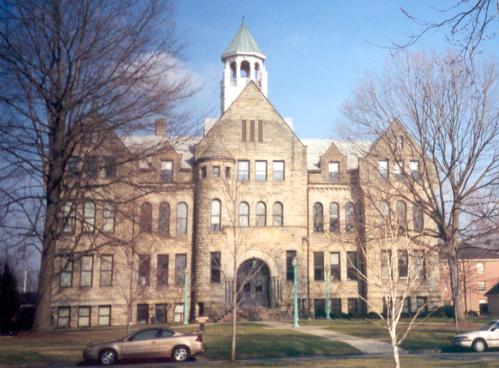 |
|
|
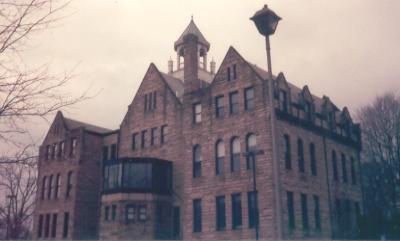 |
|
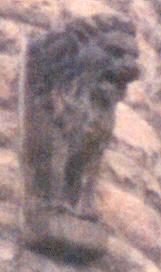 |
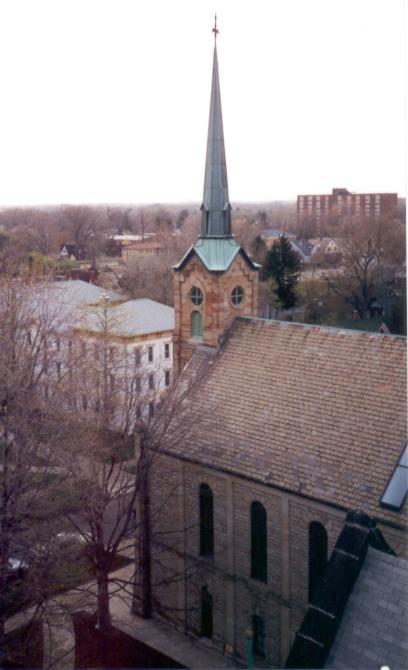 |
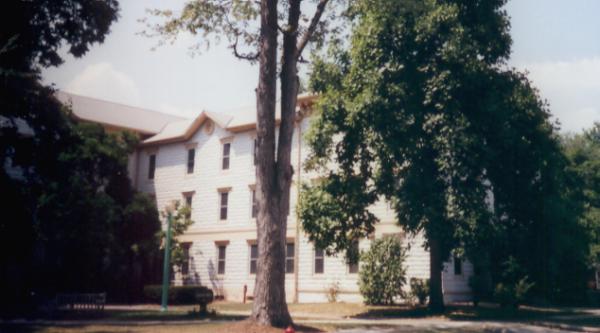 Lindsay-Crossman
Chapel (the steeple at left) used to be a German-Methodist Church before
it was purchased by the college. (I had organ
lessons in there once a week.) Lindsay-Crossman
Chapel (the steeple at left) used to be a German-Methodist Church before
it was purchased by the college. (I had organ
lessons in there once a week.)
The other building, Kohler Hall, is currently a dormitory. It is the only dorm on campus to have a coed, non-segregated floor. All other dorms have single-gender floors. (None of us really cared which gender our neighbor was, we just lived there.) Kohler hall was originally built in the mid to late 1800's as a hospital. At some point in its history it was also used as an insane asylum, but not right away. The basement was the morgue, and the upper floors were regular rooms. In the basement, there is a tunnel that leads under Seminary St. to the church (now the chapel). This tunnel was for the transporting of the dead from the morgue to their own funerals. At present, the tunnel is walled off on the chapel end, and permanently locked (the lock is plugged) at the Kohler end. Because of its past housing of the dead and dying, Kohler hall is haunted. It is one of two dorms on campus that is; both of them contain active ghosts, and new "sightings" are reported at least every other year. Kohler's ghost has been named "the blue haze" (probably based on a witness's description.) |
|
 |
This is Dietsch Hall. It currently houses the Foreign Language department and the learning center (where to go for help.) It used to be the college administration building before Bonds Hall was built. |  |
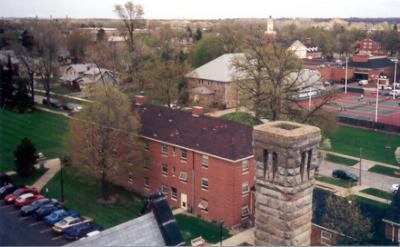 |
This is a view of Klein Hall (another dorm) from behind. Across the street from it is the Student Activies Center, or SAC. This building was once the Women's Gym (back when it was kosher to have such a building.) Behind it is the old swimming pool, now the home of the campus archery club. The tower beyond the SAC is that of the Strosacker College/Campus/Student Union. All three are used to describe it. It houses the primary campus dining facility, the Radio Station and Student Activites offices, the college Bookstore, and the Student Senate chambers and offices. |
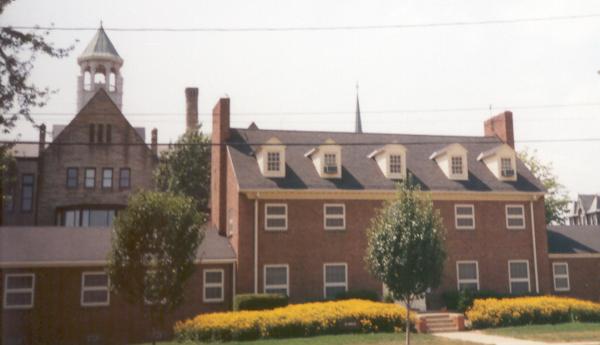 |
This building is 63 Beech Street: yet another
Dorm. This building, along with Klein Hall, Saylor Hall, and 21 Beech
Street make up the "Freshman Complex": an area where only first year students
are permitted to live. As a result of this restriction, everyone in these
four buildings, with teh possible exception of the Resident Assitants,
must move out and find new housing after one year.
Marting Tower is visible behind this building. This picture was taken from the middle of Center street. (In the next picture, Center street can be seen along one side.) |
 |
This picture, taken from Marting Tower, shows the Collins Tennis Center, and several dorms which line Tressel Street. (Center St. is on the right side.) The dorms are Ernsthausen, Heritage, and Constitution Halls, counting from right to left. Constitution is hidden by trees from this angle. These three dorms house the floors (instead of houses) of all of the fraternities and sororities on campus. |
 |
To the left is a picture of Strosacker Union.
To the right is a picture of Heritage Hall taken from the front.
|
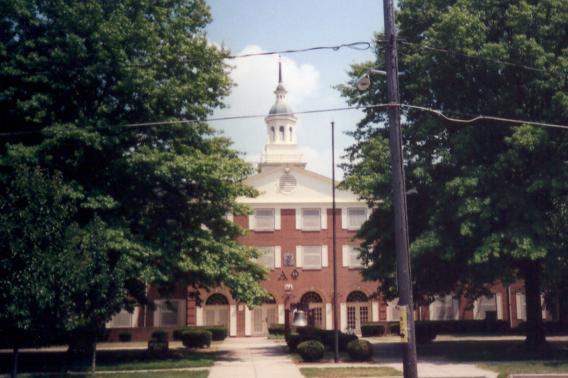
This is the Center section of Heritage Hall, which is actually shaped like a captial "I" on its side. Residents live on the upper two floors of this section. The college print shop and offices of Residence Life are on the first floor along with several Lounge/Classrooms. |
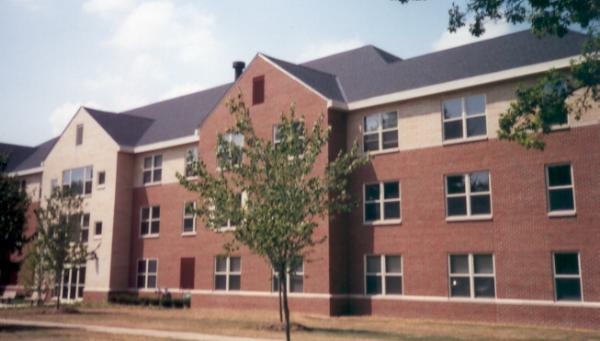 |
This is the newest dorm on campus: The Willard and Donna Carmel Living and Learning Center (we just call it "Carmel".) This dorm is unlike all of the others because it has suites. Every four people have two bedrooms, a common room, and a bathroom. As such, there are no gender specifications by floor. In order to live here, students must register for classes in their major which are specifically for them: these classes are taught in the end lounges of this dorm. This picture was taken from end of the street in front of both Carmel and the Union, up near Heritage Hall. |
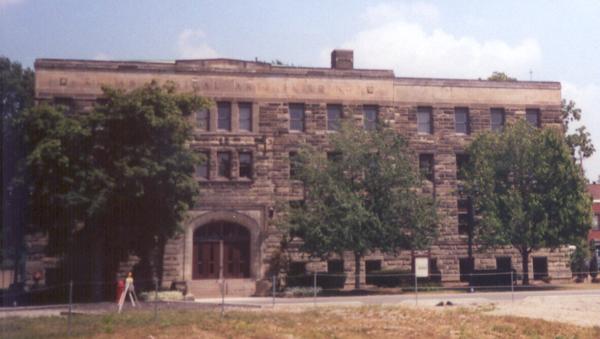 |
These two pictures are of the two
buildings that make up the Conservatory of Music: Kulas Musical Arts Building
(on top) and Merner-Pfeiffer Hall. These two buildings, along with
Marting, Dietsch, the Chapel, and Kohler are in the area that was once
German Wallace College (from this the current college
gets the name "Wallace" and the German names of many of the buildings.)
The Conservatory of music is housed entirely in these two buildings. As such, the number of students who can enroll is limited to a smaller number than most other music schools or conservatories of thsi caliber. For an entirely undergraduate instituion, the Conservatory is extremely well known. A large part of its fame comes from the activies of the Riemenschneider Bach Institute. This is a music library founded with the posessions of the founder of the conservatory itself, and housed in Merner-Pfeiffer Hall. Included in the vault collection are original copies of music dating to J.S. Bach (mid 1700's). Also in this library are music reference books, and complete collected editions of several composers (like an encyclopedia of sheet music of every piece that a person ever wrote.) The RBI is also internationally known for its semi-annual publication of the scholarly journal, BACH. The Conservatory itself is well known for many things aside from the Bach Institute. The most obvious is the perfomance level of all of its students. This is contributed to by many things: --All private teachers and many of the classroom teachers are performers in their own right. Many of them are members of the Cleveland Orchestra, the Ohio Chamber Orchestra, or other similar groups. Most of the voice teachers are currently perfoming with area opera companies, and the piano faculty are all accomplished soloists. --There is no graduate school of music connected to the Conservatory. Therefore, the performance opportunities for the undergraduates are much greater than at larger schools of music. --The Bach Institute coordinates the continuation of a tradition dating back roughly 70 years: The Baldwin-Wallace Annual Bach Festival. Each year in the spring, the orchestra and choir, along with hired solists perform one of the four major choral works of J.S. Bach, plus other smaller works of his contemporaries performed by other guest artists, and one small choral work, usually a motet, by the B-W Motet Choir. Spread over two days with Brass Choir performances from Marting tower before every concert, this event has become one way in which the Baldwin-Wallace Conservatory has received its fame. Finally, the Conservatory is the home of the Music Theater Progam. Chaired by Victoria Bussert, this program accepts less than 10 new students every year, and trains them to be the best (literally) in the business. Thanks to the efforts of this department, the college puts on at least one major musical theater of light opera production each year, in addition to the usual output of the theater department. Professionals in the field of musical theater, critics, actors, and others, have reviewed some of these performances, and had very little to compare them too short of high level, professional shows. (One person who had been associated with the unsuccessful Broadway production of Stephen Sondheim's musical Merrily We Roll Along said of the B-W production of the same show that if our production had been the one mounted on Broadway, it would have had a much better, and longer run.) |
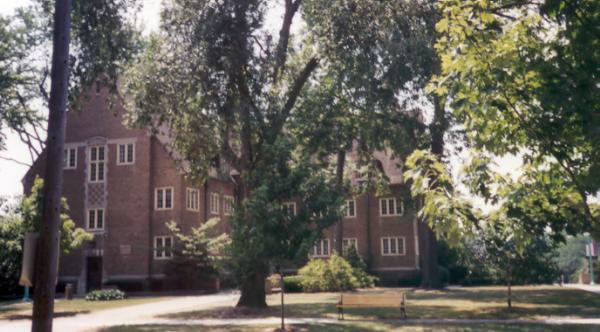 |
|
|
|
 |
||
|
This building has three components. The newest part is the Malicky building, which is located in the middle. Its clock tower is the only building tower on the northern section of the campus (all buildings north of Bagley Road) On the left is the Baldwin building, formerly the Philura Gould Baldwin Memorial Library. Before the construction of the current library, this building was the only campus library. It was then used by the East Ohio Conference of the United Methodist Church for Archival Storage. It now houses offices and lecture rooms. |
||
 |
The building on the right side, and also in the picture to the left, is Carnagie Hall. This building used be the sole home of the psychology and sociology departments, and now contains some of their offices. The "new" library, Ritter Library, can be seen next to it in the picture to the left. On the left is a closer view of the clock tower. | 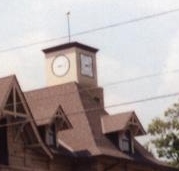 |